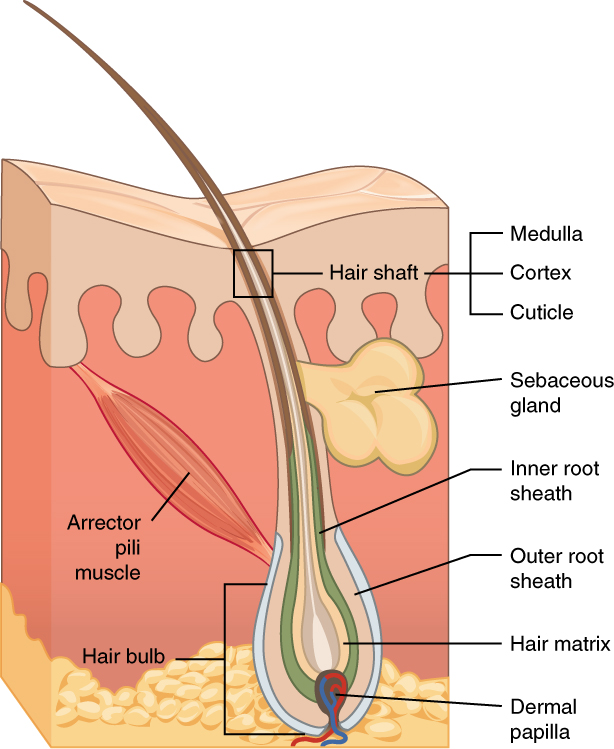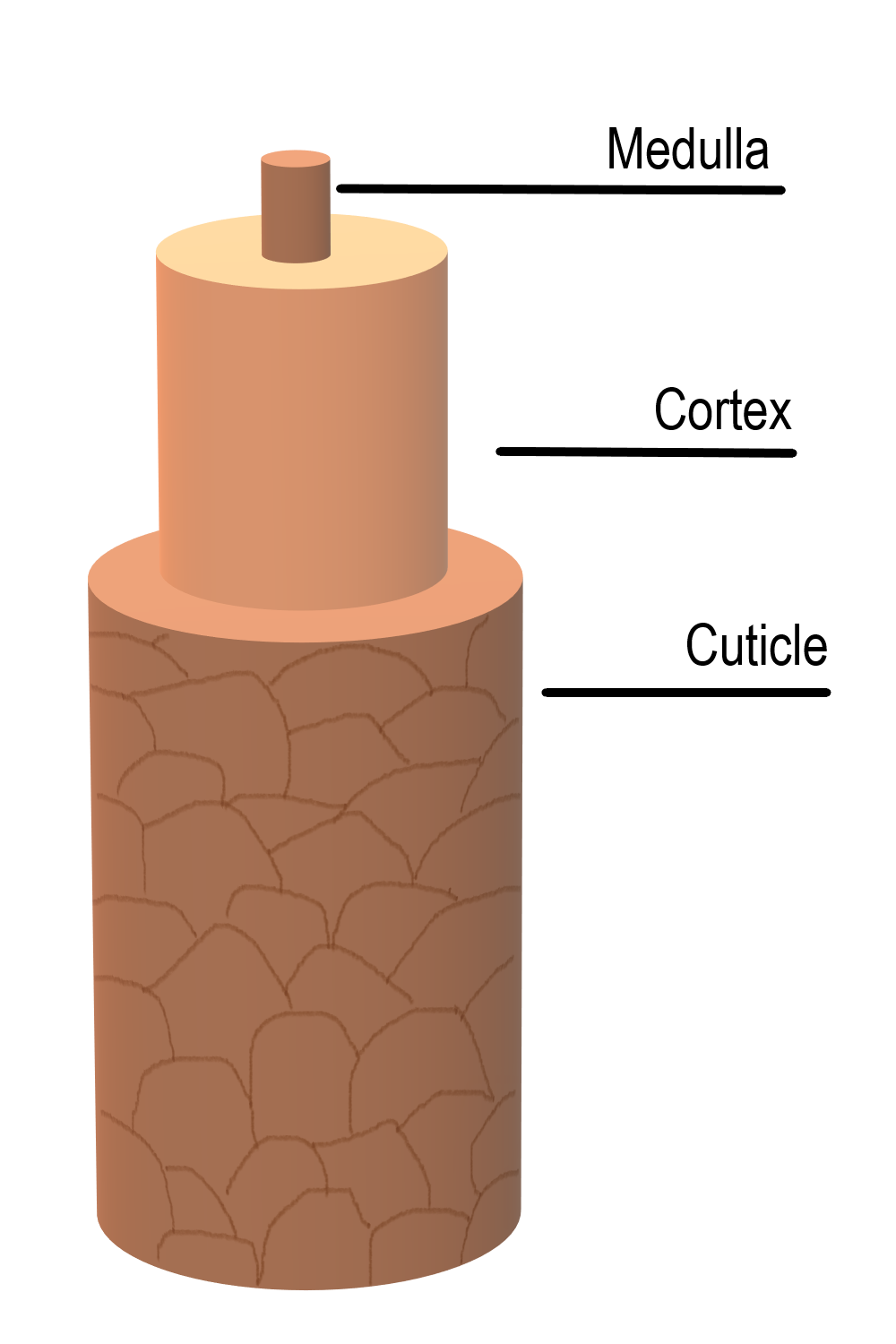|
Cuticle (hair)
Comparison of sheep (top) and human (bottom) hairs with different cuticle textures The hair cuticle is the outermost part of the hair shaft.James, William; Berger, Timothy; Elston, Dirk (2005) ''Andrews' Diseases of the Skin: Clinical Dermatology'' (10th ed.). Saunders. Page 8. . It is formed from dead cells, overlapping in layers, which form scales that strengthen and protect the hair shaft. These layers are formed of keratin proteins. The hair cuticle is also known to contain anteiso-18-methyleicosanoic acid which contribute to the hydrophobic properties of hair. Diagram of the hair shaft, indicating medulla (innermost), cortex, and cuticle (exterior) While the cuticle is the outermost layer, it is not responsible for the color of the hair. Melanin is the pigment A pigment is a powder used to add or alter color or change visual appearance. Pigments are completely or nearly solubility, insoluble and reactivity (chemistry), chemically unreactive in water or another m ... [...More Info...] [...Related Items...] OR: [Wikipedia] [Google] [Baidu] |
CSIRO ScienceImage 8115 Human Hair And Merino Wool Fibre
The Commonwealth Scientific and Industrial Research Organisation (CSIRO) is an Australian Government agency that is responsible for scientific research and its commercial and industrial applications. CSIRO works with leading organisations around the world. From its headquarters in Canberra, CSIRO maintains more than 50 sites across Australia as well as in France and the United States, employing over 6,500 people. Federally funded scientific research in Australia began in 1916 with the creation of the Advisory Council of Science and Industry. However, the council struggled due to insufficient funding. In 1926, research efforts were revitalised with the establishment of the Council for Scientific and Industrial Research (CSIR), which strengthened national science leadership and increased research funding. CSIR grew rapidly, achieving significant early successes. In 1949, legislative changes led to the renaming of the organisation as Commonwealth Scientific and Industrial Research ... [...More Info...] [...Related Items...] OR: [Wikipedia] [Google] [Baidu] |
Hair Shaft
Hair is a protein filament that grows from follicles found in the dermis. Hair is one of the defining characteristics of mammals. The human body, apart from areas of glabrous skin, is covered in follicles which produce thick terminal and fine vellus hair. Most common interest in hair is focused on hair growth, hair types, and hair care, but hair is also an important biomaterial primarily composed of protein, notably alpha-keratin. Attitudes towards different forms of hair, such as hairstyles and hair removal, vary widely across different cultures and historical periods, but it is often used to indicate a person's personal beliefs or social position, such as their age, gender, or religion. Overview Meaning The word "hair" usually refers to two distinct structures: #the part beneath the skin, called the hair follicle, or, when pulled from the skin, the bulb or root. This organ is located in the dermis and maintains stem cells, which not only re-grow the hair after it falls o ... [...More Info...] [...Related Items...] OR: [Wikipedia] [Google] [Baidu] |
Cell (biology)
The cell is the basic structural and functional unit of all life, forms of life. Every cell consists of cytoplasm enclosed within a Cell membrane, membrane; many cells contain organelles, each with a specific function. The term comes from the Latin word meaning 'small room'. Most cells are only visible under a light microscope, microscope. Cells Abiogenesis, emerged on Earth about 4 billion years ago. All cells are capable of Self-replication, replication, protein synthesis, and cell motility, motility. Cells are broadly categorized into two types: eukaryotic cells, which possess a Cell nucleus, nucleus, and prokaryotic, prokaryotic cells, which lack a nucleus but have a nucleoid region. Prokaryotes are single-celled organisms such as bacteria, whereas eukaryotes can be either single-celled, such as amoebae, or multicellular organism, multicellular, such as some algae, plants, animals, and fungi. Eukaryotic cells contain organelles including Mitochondrion, mitochondria, which ... [...More Info...] [...Related Items...] OR: [Wikipedia] [Google] [Baidu] |
Hair Shaft Diagram
Hair is a protein filament that grows from follicles found in the dermis. Hair is one of the defining characteristics of mammals. The human body, apart from areas of glabrous skin, is covered in follicles which produce thick terminal and fine vellus hair. Most common interest in hair is focused on hair growth, hair types, and hair care, but hair is also an important biomaterial primarily composed of protein, notably alpha-keratin. Attitudes towards different forms of hair, such as hairstyles and hair removal, vary widely across different cultures and historical periods, but it is often used to indicate a person's personal beliefs or social position, such as their age, gender, or religion. Overview Meaning The word "hair" usually refers to two distinct structures: #the part beneath the skin, called the hair follicle, or, when pulled from the skin, the bulb or root. This organ is located in the dermis and maintains stem cells, which not only re-grow the hair after it falls o ... [...More Info...] [...Related Items...] OR: [Wikipedia] [Google] [Baidu] |
Cuticle
A cuticle (), or cuticula, is any of a variety of tough but flexible, non-mineral outer coverings of an organism, or parts of an organism, that provide protection. Various types of "cuticle" are non- homologous, differing in their origin, structure, function, and chemical composition. Human anatomy In human anatomy, "cuticle" can refer to several structures, but it is used in general parlance, and even by medical professionals, to refer to the thickened layer of skin surrounding fingernails and toenails (the eponychium), and to refer to the superficial layer of overlapping cells covering the hair shaft ( cuticula pili), consisting of dead cells, that locks the hair into its follicle. It can also be used as a synonym for the epidermis, the outer layer of skin. Cuticle of invertebrates In zoology, the invertebrate cuticle or cuticula is a multi-layered structure outside the epidermis of many invertebrates, notably arthropods and roundworms, in which it forms an exoskeleton ... [...More Info...] [...Related Items...] OR: [Wikipedia] [Google] [Baidu] |
Human Hair Color
Human hair color is the pigmentation of human hair follicles and hair, shafts due to two types of melanin: eumelanin and pheomelanin. Generally, the more melanin present, the darker the hair. Its tone depends on the ratio of black or brown eumelanin to yellow or red pheomelanin. Melanin levels can vary over time, causing a person's hair color to change, and one person can have hair follicles of more than one color. Some hair colors are associated with some ethnic groups because of the observed higher frequency of particular hair colors within their geographical region, e.g. straight, dark hair amongst East Asians, Southeast Asians, Polynesians, some Central Asians, and Indigenous peoples of the Americas, Native Americans; a large variety of dark, fair, curly, straight, wavy or bushy amongst Europeans, West Asians, some Central Asians, and North Africans; and curly, dark, and uniquely helical hair amongst Sub Saharan Africans. Bright red hair is found in some European populations ... [...More Info...] [...Related Items...] OR: [Wikipedia] [Google] [Baidu] |
Melanin
Melanin (; ) is a family of biomolecules organized as oligomers or polymers, which among other functions provide the pigments of many organisms. Melanin pigments are produced in a specialized group of cells known as melanocytes. There are five basic types of melanin: eumelanin, pheomelanin, neuromelanin, allomelanin and pyomelanin. Melanin is produced through a multistage chemical process known as melanogenesis, where the oxidation of the amino acid tyrosine is followed by polymerization. Pheomelanin is a cysteinated form containing poly benzothiazine portions that are largely responsible for the red or yellow tint given to some skin or hair colors. Neuromelanin is found in the brain. Research has been undertaken to investigate its efficacy in treating neurodegenerative disorders such as Parkinson's. Allomelanin and pyomelanin are two types of nitrogen-free melanin. The phenotypic color variation observed in the epidermis and hair of mammals is primarily determi ... [...More Info...] [...Related Items...] OR: [Wikipedia] [Google] [Baidu] |
Pigment
A pigment is a powder used to add or alter color or change visual appearance. Pigments are completely or nearly solubility, insoluble and reactivity (chemistry), chemically unreactive in water or another medium; in contrast, dyes are colored substances which are soluble or go into solution at some stage in their use. Dyes are often organic compounds whereas pigments are often inorganic compound, inorganic. Pigments of prehistoric and historic value include ochre, charcoal, and lapis lazuli. Economic impact In 2006, around 7.4 million tons of inorganic chemistry, inorganic, organic chemistry, organic, and special pigments were marketed worldwide. According to an April 2018 report by ''Bloomberg Businessweek'', the estimated value of the pigment industry globally is $30 billion. The value of titanium dioxide – used to enhance the white brightness of many products – was placed at $13.2 billion per year, while the color Ferrari red is valued at $300 million each yea ... [...More Info...] [...Related Items...] OR: [Wikipedia] [Google] [Baidu] |
Cortex (hair)
The cortex of the hair shaft is located between the hair cuticle and medulla and is the thickest hair layer. It contains most of the hair's pigment, giving the hair its color. The major pigment in the cortex is melanin, which is also found in skin. The distribution of this pigment varies from animal to animal and person to person. In humans, the melanin is primarily denser nearer the cuticle whereas in animals, melanin is primarily denser nearer the medulla.James, William; Berger, Timothy; Elston, Dirk (2005) ''Andrews' Diseases of the Skin: Clinical Dermatology'' (10th ed.). Saunders. Page 8. . See also * List of distinct cell types in the adult human body The list of human cell types provides an enumeration and description of the various specialized cells found within the human body, highlighting their distinct functions, characteristics, and contributions to overall physiological processes. Cell ... References Hair anatomy {{Dermatology-stub ... [...More Info...] [...Related Items...] OR: [Wikipedia] [Google] [Baidu] |
List Of Distinct Cell Types In The Adult Human Body
The list of human cell types provides an enumeration and description of the various specialized cells found within the human body, highlighting their distinct functions, characteristics, and contributions to overall physiological processes. Cells may be classified by their physiological function, histology (microscopic anatomy), lineage, or gene expression. Total number of cells The adult human body is estimated to contain about 30 trillion (3×1013) human cells, with the number varying between 20 and 100 trillion depending on factors such as sex, age, and weight. Additionally, there are approximately an equal number of bacterial cells. The exact count of human cells has not yet been empirically measured in its entirety and is estimated using different approaches based on smaller samples of empirical observation. It is generally assumed that these cells share features with each other and thus may be organized as belonging to a smaller number of types. Classification ... [...More Info...] [...Related Items...] OR: [Wikipedia] [Google] [Baidu] |






